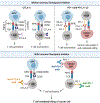Mechanisms and clinical manifestations of cardiovascular toxicities associated with immune checkpoint inhibitors
- PMID: 33686402
- PMCID: PMC8647663
- DOI: 10.1042/CS20200331
Mechanisms and clinical manifestations of cardiovascular toxicities associated with immune checkpoint inhibitors
Abstract
Immunotherapies have greatly expanded the armamentarium of cancer-directed therapies in the past decade, allowing the immune system to recognize and fight cancer. Immune checkpoint inhibitors (ICIs), in particular, have revolutionized cancer treatment and have demonstrated survival benefit in numerous types of cancer. These monoclonal antibodies increase anti-cancer immunity by blocking down-regulators of adaptive immunity, including cytotoxic T lymphocyte-associated protein 4 (CTLA-4), programmed cell death protein 1 (PD-1), and its ligand (PD-L1), resulting in anti-tumor activity. As ICIs increase immune system activation, they can cause a wide range of inflammatory side effects, termed immune-released adverse events. Though these toxicities can affect nearly any organ, the most fatal toxicity is myocarditis. Here, we discuss the diverse spectrum of cardiovascular toxicities associated with ICI use. In addition, we provide insight and future directions on mechanisms and treatments for immune-related adverse events (irAEs) involving the myocardium, pericardium, vasculature, and conduction system.
Keywords: autoimmunity; cardiovascular disease; heart failure; immunomodulation.
© 2021 The Author(s). Published by Portland Press Limited on behalf of the Biochemical Society.
Figures




Similar articles
-
Cardiovascular toxicities associated with immune checkpoint inhibitors.Cardiovasc Res. 2019 Apr 15;115(5):854-868. doi: 10.1093/cvr/cvz026. Cardiovasc Res. 2019. PMID: 30715219 Free PMC article. Review.
-
Factors affecting tumor responders and predictive biomarkers of toxicities in cancer patients treated with immune checkpoint inhibitors.Int Immunopharmacol. 2020 Aug;85:106628. doi: 10.1016/j.intimp.2020.106628. Epub 2020 May 28. Int Immunopharmacol. 2020. PMID: 32474388 Review.
-
How can we manage the cardiac toxicity of immune checkpoint inhibitors?Expert Opin Drug Saf. 2021 Jun;20(6):685-694. doi: 10.1080/14740338.2021.1906860. Epub 2021 Apr 1. Expert Opin Drug Saf. 2021. PMID: 33749484 Review.
-
Immune-related adverse events in various organs caused by immune checkpoint inhibitors.Allergol Int. 2022 Apr;71(2):169-178. doi: 10.1016/j.alit.2022.01.001. Epub 2022 Jan 29. Allergol Int. 2022. PMID: 35101349 Review.
-
Immune checkpoint inhibitors associated cardiovascular immune-related adverse events.Front Immunol. 2024 Feb 5;15:1340373. doi: 10.3389/fimmu.2024.1340373. eCollection 2024. Front Immunol. 2024. PMID: 38375475 Free PMC article. Review.
Cited by
-
A case report: interstitial pneumonia following treatment of gastric cancer with sintilimab in combination with S-1.Front Pharmacol. 2025 Feb 5;16:1508558. doi: 10.3389/fphar.2025.1508558. eCollection 2025. Front Pharmacol. 2025. PMID: 39981179 Free PMC article.
-
Immune checkpoint inhibitor-associated cardiovascular toxicities: A review.Heliyon. 2024 Feb 9;10(5):e25747. doi: 10.1016/j.heliyon.2024.e25747. eCollection 2024 Mar 15. Heliyon. 2024. PMID: 38434280 Free PMC article. Review.
-
Clinical Features and Outcomes of Immune Checkpoint Inhibitor-Associated Cardiovascular Toxicities.Acta Cardiol Sin. 2022 Jan;38(1):39-46. doi: 10.6515/ACS.202201_38(1).20210830B. Acta Cardiol Sin. 2022. PMID: 35068882 Free PMC article.
-
Early detection of immune checkpoint inhibitor-related subclinical cardiotoxicity: A pilot study by using speckle tracking imaging and three-dimensional echocardiography.Front Cardiovasc Med. 2022 Dec 21;9:1087287. doi: 10.3389/fcvm.2022.1087287. eCollection 2022. Front Cardiovasc Med. 2022. PMID: 36620612 Free PMC article.
-
Cardiovascular adverse effects of immunotherapy in cancer: insights and implications.Front Oncol. 2025 Jun 18;15:1601808. doi: 10.3389/fonc.2025.1601808. eCollection 2025. Front Oncol. 2025. PMID: 40606990 Free PMC article. Review.
References
Publication types
MeSH terms
Substances
Grants and funding
LinkOut - more resources
Full Text Sources
Other Literature Sources
Medical
Research Materials
Miscellaneous

